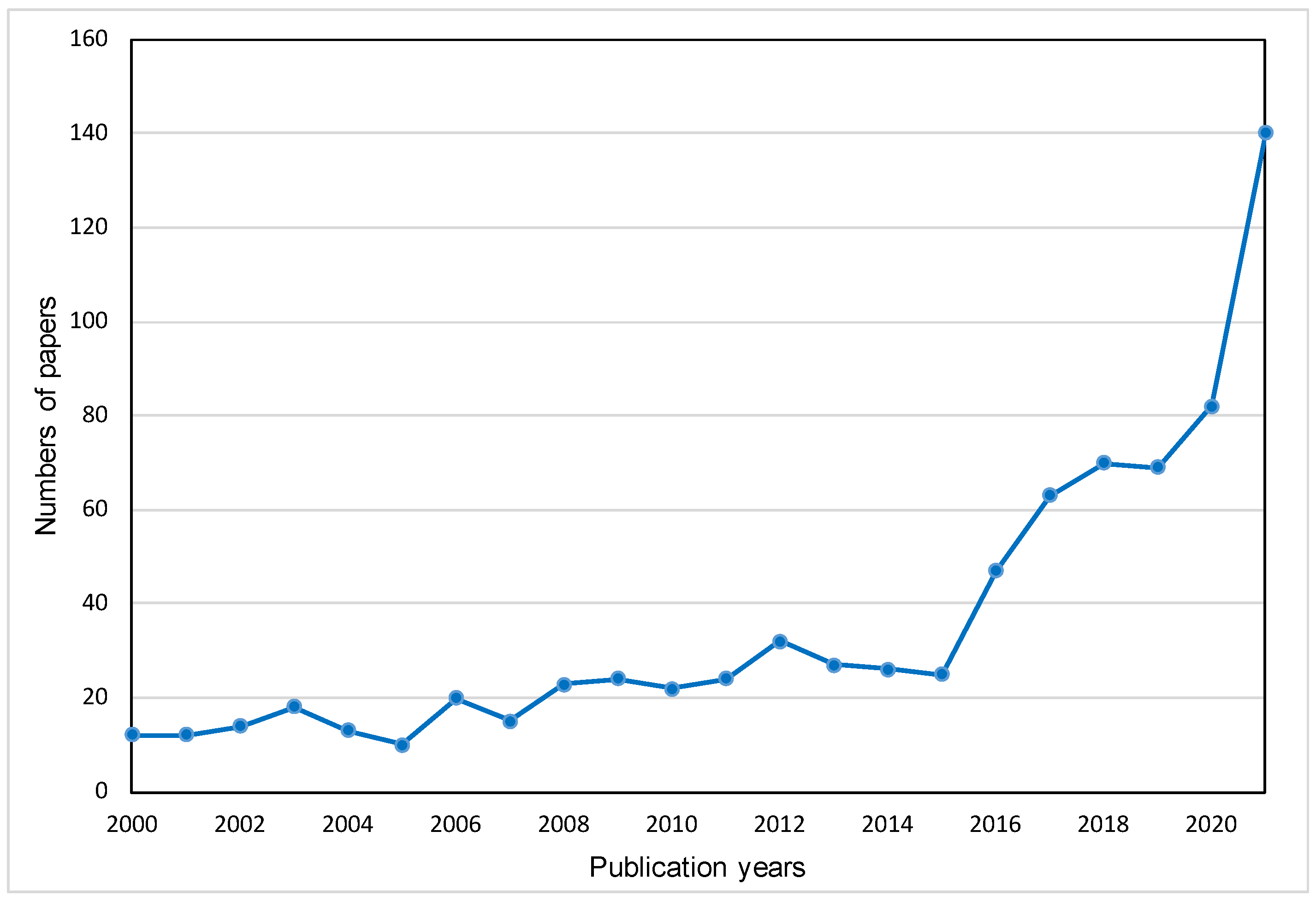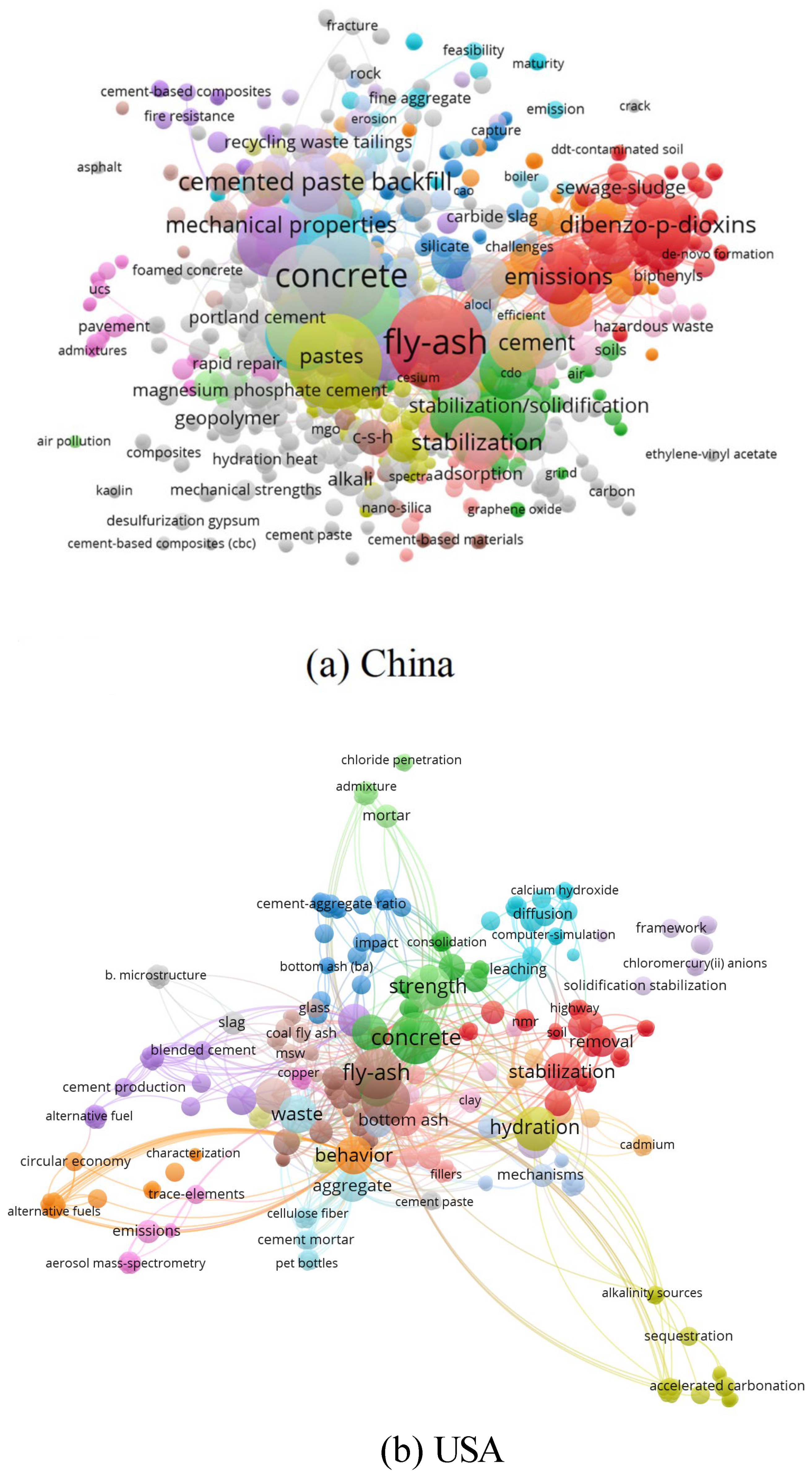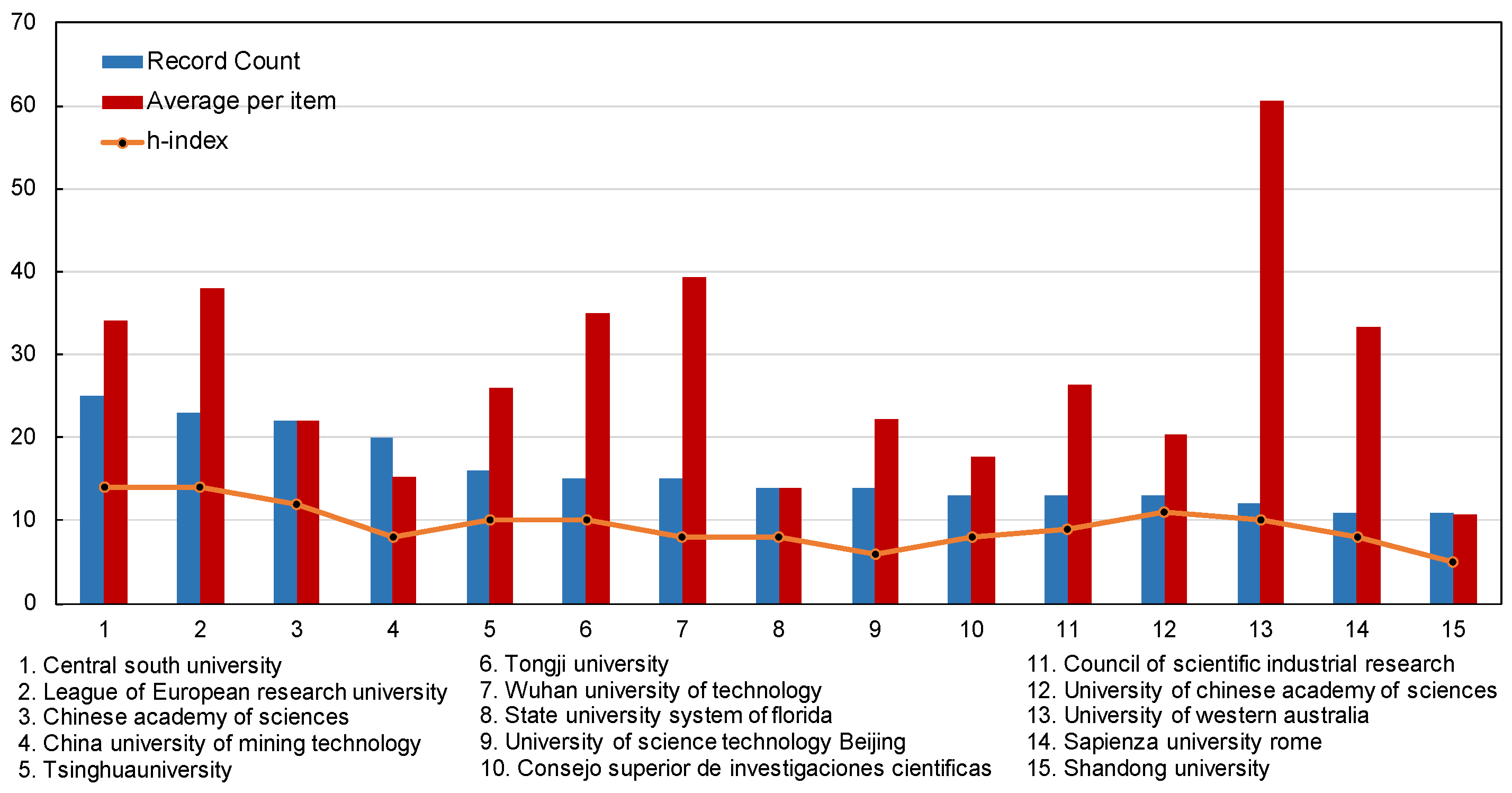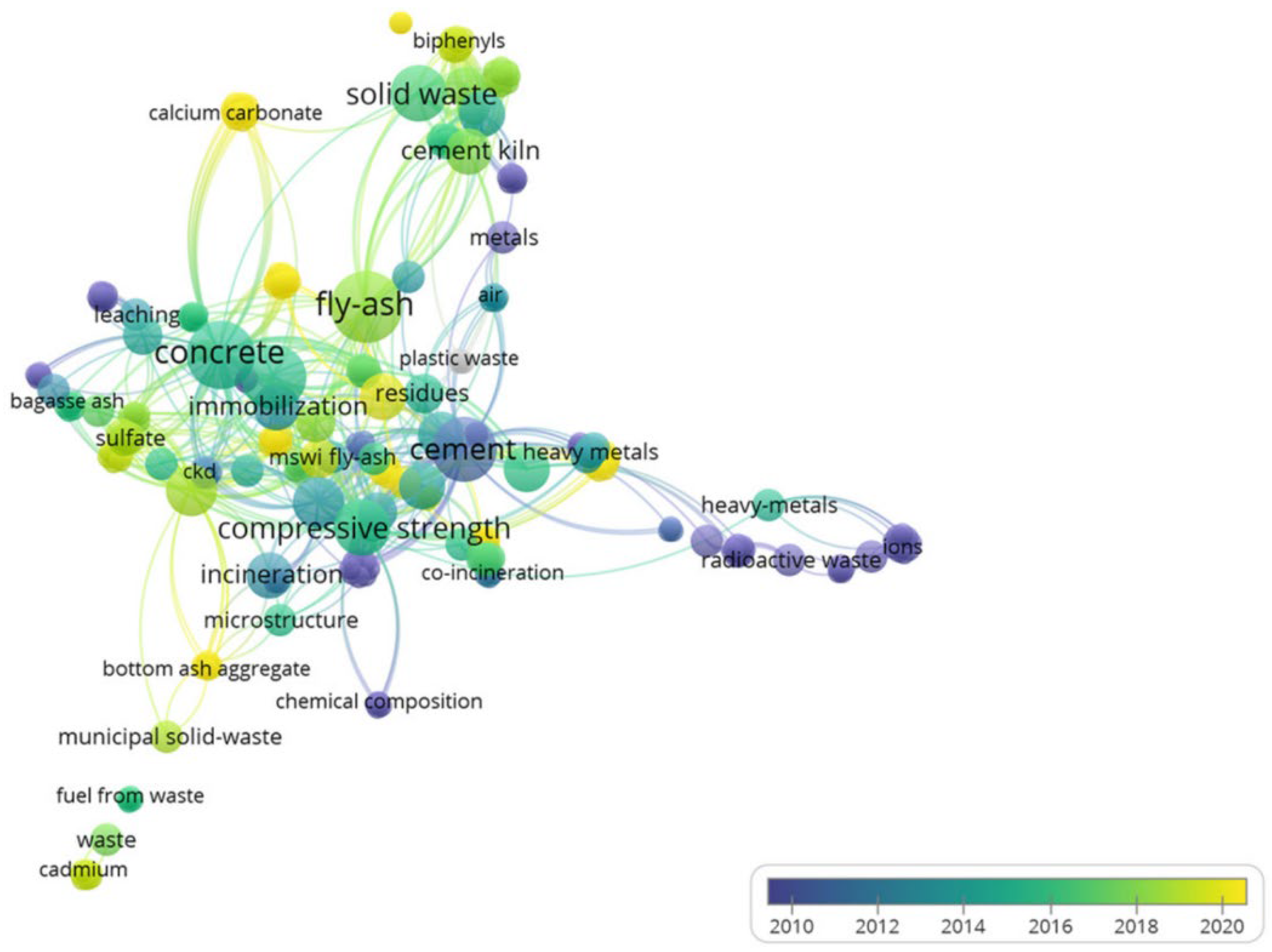Global Bibliometric Developments on Solid Waste Recycling in Concrete Construction Engineering
Abstract
:1. Introduction
2. Methodology and Data Resource
2.1. Data Resources
2.2. Methodology
3. Results Analysis
3.1. General Trends
3.2. Global Bibliometric Status
3.2.1. Country Statistics of Solid Waste Recycling
3.2.2. Institution Statistics of Solid Waste Recycling
3.3. Research Focus and Future Directions
3.3.1. The Most Studied Solid Waste
3.3.2. Keyword Analysis
3.3.3. Top-Cited Papers
3.3.4. Future Directions
3.4. Limitations
4. Conclusions
- China and the USA are the top two countries that have made the most effect on recycling solid waste in concrete construction engineering. Bibliometric analysis shows that China is the most productive country with 282 peer-reviewed articles, more than four times the amount of articles produced by the USA. There was little difference in the number of publications and the H-index among the top productive institutions.
- By comparing t co-occurrence of keywords, it demonstrates that China prefers to concentrate on solid waste reuse and environmental effects while the USA pays more attention to the strength, hydration effect and stabilization.
- Fly ash is the most widely studied and recycled solid waste in the world. The country with the most publications was China, from which papers discussing fly ash accounted for 48.9% of solid waste publications.
- Keywords can be divided into seven clusters according to their link strength, which are, respectively, related to solid waste categories, construction materials, performance characteristics, impact elements, treatments, synthetic products and others. The top five keywords with the highest frequency are fly ash (113), hydration (95), concrete (82), compressive strength (74), solid waste (67).
- The list of most cited papers shows that half of the top ten-cited papers are in connection with fly ash. Industry solid wastes, such as heavy metals were another most focused on solid waste in concrete construction engineering.
Funding
Data Availability Statement
Acknowledgments
Conflicts of Interest
References
- Popel, F. The joint recycling of solid and liquid waste. Gesundheits-Ingenieur 1948, 69, 17–21. [Google Scholar] [PubMed]
- Chalangaran, N.; Farzampour, A.; Paslar, N.; Fatemi, H. Experimental investigation of sound transmission loss in concrete containing recycled rubber crumbs. Adv. Concr. Constr. 2021, 11, 447–454. [Google Scholar]
- Chalangaran, N.; Farzampour, A.; Paslar, N. Nano Silica and Metakaolin Effects on the Behavior of Concrete Containing Rubber Crumbs. CivilEng 2020, 1, 264–274. [Google Scholar] [CrossRef]
- Iman, M.; Shahheidari, F.S.; Hashemi, S.; Farzampour, A. Investigation of steel fiber effects on concrete abrasion resistance. Adv. Concr. Constr. 2020, 9, 367–374. [Google Scholar]
- Al-Salem, S.M.; Lettieri, P.; Baeyens, J. Recycling and recovery routes of plastic solid waste (PSW): A review. Waste Manag. 2009, 29, 2625–2643. [Google Scholar] [CrossRef]
- Pan, J.R.; Huang, C.; Kuo, J.-J.; Lin, S.-H. Recycling MSWI bottom and fly ash as raw materials for Portland cement. Waste Manag. 2008, 28, 1113–1118. [Google Scholar] [CrossRef]
- Wang, L.; Jin, Y.; Nie, Y.; Li, R. Recycling of municipal solid waste incineration fly ash for ordinary Portland cement production: A real-scale test. Resour. Conserv. Recycl. 2010, 54, 1428–1435. [Google Scholar] [CrossRef]
- Shi, H.; Shi, J.; Wang, L.; Yuan, L. Research on potential cementitious reactivity and immobilisation effect by Portland cement on MSW fly ash. Adv. Cem. Res. 2006, 18, 35–40. [Google Scholar] [CrossRef]
- Yang, L.; Chen, Z.; Liu, T.; Gong, Z.; Yu, Y.; Wang, J. Global trends of solid waste research from 1997 to 2011 by using bibliometric analysis. Scientometrics 2012, 96, 133–146. [Google Scholar] [CrossRef]
- Li, X.-G.; Lv, Y.; Ma, B.-G.; Chen, Q.-B.; Yin, X.-B.; Jian, S.-W. Utilization of municipal solid waste incineration bottom ash in blended cement. J. Clean. Prod. 2012, 32, 96–100. [Google Scholar] [CrossRef]
- Xue, Y.; Hou, H.; Zhu, S.; Zha, J. Utilization of municipal solid waste incineration ash in stone mastic asphalt mixture: Pavement performance and environmental impact. Constr. Build. Mater. 2009, 23, 989–996. [Google Scholar] [CrossRef]
- Yao, C.; Guo, Y.; Shen, A.; Cui, W.; He, Z. Recycling of fine-asphalt-pavement solid waste for low-shrinkage rapid hardening Portland cement concrete pavement. Constr. Build. Mater. 2021, 289, 123132. [Google Scholar] [CrossRef]
- Ghazi, A.B.; Jamshidi-Zanjani, A.; Nejati, H. Clinkerisation of copper tailings to replace Portland cement in concrete construction. J. Build. Eng. 2022, 51, 104275. [Google Scholar] [CrossRef]
- Ghazi, A.B.; Jamshidi-Zanjani, A.; Nejati, H. Utilization of copper mine tailings as a partial substitute for cement in concrete construction. Constr. Build. Mater. 2021, 317, 125921. [Google Scholar] [CrossRef]
- Moed, H.F. Measuring China”s research performance using the Science Citation Index. Scientometrics 2002, 53, 281–296. [Google Scholar] [CrossRef]
- Huang, Y.; Bird, R.N.; Heidrich, O. A review of the use of recycled solid waste materials in asphalt pavements. Resour. Conserv. Recycl. 2007, 52, 58–73. [Google Scholar] [CrossRef]
- Siddique, R.; Rajor, A. Use of cement kiln dust in cement concrete and its leachate characteristics. Resour. Conserv. Recycl. 2012, 61, 59–68. [Google Scholar] [CrossRef]
- Siddique, R.; Chahal, N. Use of silicon and ferrosilicon industry by-products (silica fume) in cement paste and mortar. Resour. Conserv. Recycl. 2011, 55, 739–744. [Google Scholar] [CrossRef]
- Siddique, R. Utilization of cement kiln dust (CKD) in cement mortar and concrete—An overview. Resour. Conserv. Recycl. 2006, 48, 315–338. [Google Scholar] [CrossRef]
- Siddique, R. Utilization of municipal solid waste (MSW) ash in cement and mortar. Resour. Conserv. Recycl. 2010, 54, 1037–1047. [Google Scholar] [CrossRef]
- Ye, Z.; Zhang, B.; Liu, Y.; Zhang, J.; Wang, Z.; Bi, H. A bibliometric investigation of research trends on sulfate removal. Desalin. Water Treat. 2013, 52, 6040–6049. [Google Scholar] [CrossRef]
- Wang, L.; Zhang, Y.; Chen, L.; Guo, B.; Tan, Y.; Sasaki, K.; Tsang, D.C. Designing novel magnesium oxysulfate cement for stabilization/solidification of municipal solid waste incineration fly ash. J. Hazard. Mater. 2021, 423, 127025. [Google Scholar] [CrossRef] [PubMed]
- Bayoumi, T.A.; Tawfik, M.E. Immobilization of sulfate waste simulate in polymer-cement composite based on recycled expanded polystyrene foam waste: Evaluation of the final waste form under freeze-thaw treatment. Polym. Compos. 2015, 38, 637–645. [Google Scholar] [CrossRef]
- Wang, N.; Yu, H.; Bi, W.; Gong, W.; Zhang, N.; Tan, Y.; Wu, C. Influence of fly ash on the properties of magnesium oxysulfate cement. Emerg. Mater. Res. 2021, 10, 58–65. [Google Scholar] [CrossRef]
- Das, B.; Prakash, S.; Reddy, P.S.R.; Misra, V.N. An overview of utilization of slag and sludge from steel industries. Resour. Conserv. Recycl. 2007, 50, 40–57. [Google Scholar] [CrossRef]
- Valls, S.; Vazquez, E. Accelerated carbonation of sewage sludge-cement-sand mortars and its environmental impact. Cem. Concr. Res. 2021, 31, 1271–1276. [Google Scholar] [CrossRef]
- Jing, C.; Liu, S.; Meng, X. Arsenic leachability and speciation in cement immobilized water treatment sludge. Chemosphere 2005, 59, 1241–1247. [Google Scholar] [CrossRef]
- Karamalidis, A.K.; Voudrias, E.A. Cement-based stabilization/solidification of oil refinery sludge: Leaching behavior of alkanes and PAHs. J. Hazard. Mater. 2007, 148, 122–135. [Google Scholar] [CrossRef]
- Dermatas, D.; Meng, X. Utilization of fly ash for stabilization/solidification of heavy metal contaminated soils. Eng. Geol. 2003, 70, 377–394. [Google Scholar] [CrossRef]
- Mahedi, M.; Cetin, B.; Dayioglu, A.Y. Effect of cement incorporation on the leaching characteristics of elements from fly ash and slag treated soils. J. Environ. Manag. 2019, 253, 109720. [Google Scholar] [CrossRef]
- Liang, S.H.; Chen, J.T.; Guo, M.X. Utilization of pretreated municipal solid waste incineration fly ash for cement-stabilized soil. Waste Manag. 2020, 105, 425–432. [Google Scholar] [CrossRef] [PubMed]
- Zhou, Y.; Liu, G.; Liu, J.; Xiao, Y.; Wang, T.; Xue, Y. Magnetic biochar prepared by electromagnetic induction pyrolysis of cellulose: Biochar characterization, mechanism of magnetization and adsorption removal of chromium (VI) from aqueous solution. Bioresour. Technol. 2021, 337, 125429. [Google Scholar] [CrossRef] [PubMed]
- El-Said, N.; Sayed, M.S.; Mikhail, A.S. Influence of Doping of NaNO3 on the Solid Phase Thermal Decomposition of Bitumen and Cement. J. Therm. Anal. 2001, 63, 525–532. [Google Scholar] [CrossRef]
- Hernández, S.; Guerrero, A.; Gonñi, S. Leaching of borate waste cement matrices: Pore solution and solid phase characterization. Adv. Cem. Res. 2000, 12, 1–8. [Google Scholar] [CrossRef]
- Kienzler, B.; Vejmelka, P.; Herbert, H.-J.; Meyer, H.; Altenhein-Haese, C. Long-Term Leaching Experiments of Full-Scale Cemented Waste Forms: Experiments and Modeling. Nucl. Technol. 2000, 129, 101–118. [Google Scholar] [CrossRef]
- Ludwig, C.; Johnson, C.; Käppeli, M.; Ulrich, A.; Riediker, S. Hydrological and geochemical factors controlling the leaching of cemented MSWI air pollution control residues: A lysimeter field study. J. Contam. Hydrol. 2000, 42, 253–272. [Google Scholar] [CrossRef]
- Clark, R.M.; Gillean, J.I. Systems Analysis and Solid Waste Planning. J. Environ. Eng. Div. 1974, 101, 666–667. [Google Scholar] [CrossRef]
- Katritsis, D.G. Journal Impact Factor: Widely Used, Misused and Abused. Arrhythmia Electrophysiol. Rev. 2019, 8, 153–155. [Google Scholar] [CrossRef]
- Chen, Q.; Tyrer, M.; Hills, C.; Yang, X.; Carey, P. Immobilisation of heavy metal in cement-based solidification/stabilisation: A review. Waste Manag. 2009, 29, 390–403. [Google Scholar] [CrossRef]
- Li, X.D.; Poon, C.S.; Sun, H.; Lo, I.M.C.; Kirk, D.W. Heavy metal speciation and leaching behaviors in cement based solidified/stabilized waste materials. J. Hazard. Mater. 2021, 82, 215–230. [Google Scholar] [CrossRef]
- Kang, H.-Y.; Schoenung, J. Electronic waste recycling: A review of U.S. infrastructure and technology options. Resour. Conserv. Recycl. 2005, 45, 368–400. [Google Scholar] [CrossRef]
- Bertos, M.F.; Simons, S.J.R.; Hills, C.D.; Carey, P.J. A review of accelerated carbonation technology in the treatment of cement-based materials and sequestration of CO2. J. Hazard. Mater. 2004, 112, 193–205. [Google Scholar]
- Matschei, T.; Lothenbach, B.; Glasser, F.P. Thermodynamic properties of Portland cement hydrates in the system CaO-Al2O3-SiO2-CaSO4-CaCO3-H2O. Cem. Concr. Res. 2007, 37, 1379–1410. [Google Scholar] [CrossRef]
- Huntzinger, D.N.; Gierke, J.S.; Kawatra, S.K.; Eisele, T.C.; Sutter, L.L. Carbon Dioxide Sequestration in Cement Kiln Dust through Mineral Carbonation. Environ. Sci. Technol. 2009, 43, 1986–1992. [Google Scholar] [CrossRef]
- Duxson, P.; Provis, J.L. Designing Precursors for Geopolymer Cements. J. Am. Ceram. Soc. 2008, 91, 3864–3869. [Google Scholar] [CrossRef]
- Singh, T.S.; Pant, K.K. Solidification/stabilization of arsenic containing solid wastes using portland cement, fly ash and polymeric materials. J. Hazard. Mater. 2006, 131, 29–36. [Google Scholar] [CrossRef]
- Lothenbach, B.; Matschei, T.; Moschner, G.; Glasser, F.P. Thermodynamic modelling of the effect of temperature on the hydration and porosity of Portland cement. Cem. Concr. Res. 2008, 38, 1–18. [Google Scholar] [CrossRef]






| Countries | Number of Papers | H-Index | Average per Item |
|---|---|---|---|
| China | 282 | 41 | 20.62 |
| USA | 66 | 23 | 27.76 |
| Spain | 44 | 17 | 26.93 |
| France | 39 | 20 | 33.92 |
| India | 37 | 18 | 28.43 |
| Italy | 35 | 16 | 23.6 |
| UK | 34 | 13 | 43.67 |
| Taiwan | 31 | 15 | 26.61 |
| Australia | 29 | 16 | 46.31 |
| Brazil | 29 | 11 | 17.31 |
| Egypt | 29 | 14 | 22.52 |
| Canada | 22 | 14 | 45.55 |
| South Korea | 21 | 9 | 18.48 |
| Japan | 19 | 11 | 32.68 |
| Germany | 18 | 7 | 13.06 |
| Totals | 729 | 245 | 427.45 |
| Affiliations | Record Count | H-Index | Average per Item |
|---|---|---|---|
| Central South University | 25 | 14 | 34.04 |
| League of European Research Universities | 23 | 14 | 37.96 |
| Chinese Academy of Sciences | 22 | 12 | 22.09 |
| China University of Mining Technology | 20 | 8 | 15.25 |
| Tsinghua University | 16 | 10 | 26 |
| Tongji University | 15 | 10 | 34.93 |
| Wuhan University of Technology | 15 | 8 | 39.4 |
| State University System of Florida | 14 | 8 | 14 |
| University of Science & Technology, Beijing | 14 | 6 | 22.14 |
| Consejo Superior de Investigaciones Cientificas | 13 | 8 | 17.77 |
| Council of Scientific Industrial Research | 13 | 9 | 26.31 |
| University of Chinese Academy of Sciences | 13 | 11 | 20.23 |
| University of Western Australia | 12 | 10 | 60.58 |
| Sapienza University, Rome | 11 | 8 | 33.36 |
| Shandong University | 11 | 5 | 10.73 |
| Published Year | Numbers | Published Year | Numbers | Countries | Numbers | Countries | Numbers |
|---|---|---|---|---|---|---|---|
| 2021 | 43 | 2016 | 24 | China | 135 | Australia | 12 |
| 2020 | 32 | 2015 | 9 | USA | 35 | Italy | 12 |
| 2019 | 28 | 2014 | 7 | Taiwan | 26 | England | 11 |
| 2018 | 39 | 2013 | 11 | India | 15 | France | 11 |
| 2017 | 29 | 2012 | 12 | Spain | 13 | Japan | 9 |
| Totals | 234 | Totals | 279 | ||||
| Cluster | Keywords | Link Strength | Cluster | Keywords | Link Strength | Cluster | Keywords | Link Strength |
|---|---|---|---|---|---|---|---|---|
| Solid waste categories (434) | fly ash | 113 | Construction Materials (342) | Performance Characteristics (262) | ||||
| solid waste | 67 | |||||||
| municipal solid waste | 45 | concrete | 82 | compressive strength | 74 | |||
| bottom ash | 37 | cement | 60 | behavior | 53 | |||
| municipal solid waste incineration bottom ash | 36 | Portland cement | 50 | performance | 48 | |||
| residues | 33 | clinker | 49 | microstructure | 25 | |||
| persistent organic pollutants | 29 | cement kiln | 48 | solidification | 21 | |||
| slag | 29 | aggregate | 35 | stabilization | 21 | |||
| tailings | 24 | cement industry | 18 | sorption | 20 | |||
| MSWI bottom | 21 | |||||||
| Impact elements (162) | Treatments (184) | Synthetic products (60) | alternative fuels | 18 | ||||
| dibenzo-p-dioxins | 51 | hydration | 95 | cemented paste backfill | 24 | |||
| polychlorinated naphthalenes | 43 | immobilization | 32 | solid recovered fuels | 18 | |||
| phosphogypsum | 21 | incineration | 27 | Others (112) | heavy metals | 30 | ||
| sulfate | 24 | recycling | 30 | model | 29 | |||
| temperature | 23 | plant | 27 | |||||
| management | 26 |
| Title | The First Author | Journal | Cited | Publication Year | Country |
|---|---|---|---|---|---|
| Thermodynamic modeling of the effect of temperature on the hydration and porosity of Portland cement [47] | Lothenbach, B | CCR | 535 | 2007 | Switzerland |
| A review of accelerated carbonation technology in the treatment of cement-based materials and sequestration of CO2 [42] | Fernandez Bertos, M | JHM | 528 | 2004 | England |
| Thermodynamic properties of Portland cement hydrates in the system CaO–Al2O3–SiO2–CaSO4–CaCO3–H2O [43] | Matschei, T | CCR | 361 | 2007 | Switzerland |
| Immobilization of heavy metal in cement-based solidification/stabilization: A review [39] | Chen, QY | WM | 341 | 2009 | China |
| Designing Precursors for Geopolymer Cements [45] | Duxson, P | Journal of the American Ceramic Society | 330 | 2008 | UK |
| Heavy metal speciation and leaching behaviors in cement-based solidified/stabilized waste materials [40] | Li, XD | JHM | 274 | 2001 | China |
| Carbon Dioxide Sequestration in Cement Kiln Dust through Mineral Carbonation [44] | Huntzinger, DN | Environmental Science & Technology | 192 | 2009 | USA |
| Recycling MSWI bottom and fly ash as raw materials for Portland cement [6] | Pan, JR | WM | 175 | 2008 | Taiwan |
| Solidification/stabilization of arsenic-containing solid wastes using portland cement, fly ash and polymeric materials [46] | Singh, TS | JHM | 164 | 2006 | India |
| Utilization of municipal solid waste incineration bottom ash in blended cement [10] | Li, XG | JLCP | 157 | 2012 | China |
Publisher’s Note: MDPI stays neutral with regard to jurisdictional claims in published maps and institutional affiliations. |
© 2022 by the authors. Licensee MDPI, Basel, Switzerland. This article is an open access article distributed under the terms and conditions of the Creative Commons Attribution (CC BY) license (https://creativecommons.org/licenses/by/4.0/).
Share and Cite
Zhang, X.; Xiao, Y.; Xue, Y.; Liu, J.; Chen, Z.; Zhang, R. Global Bibliometric Developments on Solid Waste Recycling in Concrete Construction Engineering. Materials 2022, 15, 4142. https://doi.org/10.3390/ma15124142
Zhang X, Xiao Y, Xue Y, Liu J, Chen Z, Zhang R. Global Bibliometric Developments on Solid Waste Recycling in Concrete Construction Engineering. Materials. 2022; 15(12):4142. https://doi.org/10.3390/ma15124142
Chicago/Turabian StyleZhang, Xiaoshan, Yue Xiao, Yongjie Xue, Jian Liu, Zongwu Chen, and Ronghui Zhang. 2022. "Global Bibliometric Developments on Solid Waste Recycling in Concrete Construction Engineering" Materials 15, no. 12: 4142. https://doi.org/10.3390/ma15124142
APA StyleZhang, X., Xiao, Y., Xue, Y., Liu, J., Chen, Z., & Zhang, R. (2022). Global Bibliometric Developments on Solid Waste Recycling in Concrete Construction Engineering. Materials, 15(12), 4142. https://doi.org/10.3390/ma15124142








